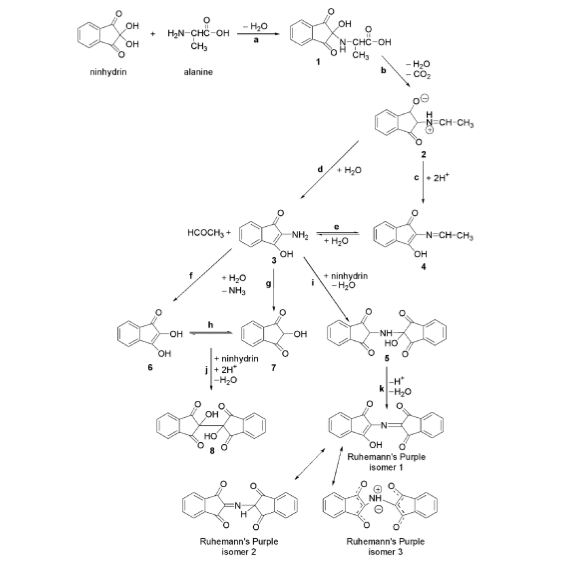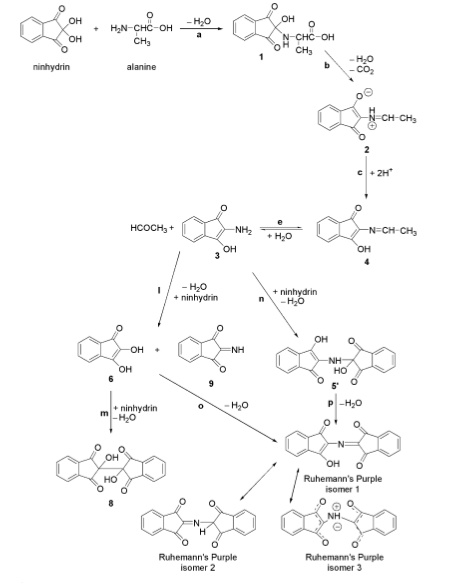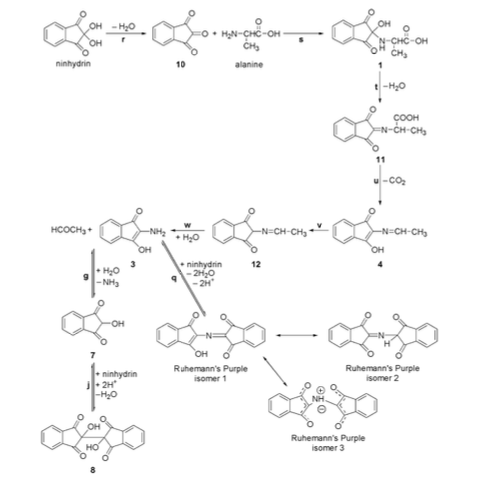Difference between revisions of "Ninhydrin Reaction with Alanine in Latent Fingerprints"
| Line 1: | Line 1: | ||
| − | This is an ab initio computational chemistry project and all energies of the compounds in this multi-step reaction were calculated via WebMo, using Hartree-Fock 6-31G | + | This is an ab initio computational chemistry project and all energies of the compounds in this multi-step reaction were calculated via WebMo, using the Hartree-Fock theory and 6-31G basis set to calculate molecular energy. |
===Background=== | ===Background=== | ||
Fingerprinting is an important tool used in forensic science and solving crimes. Latent fingerprints is one of the easiest ways to connect an individual with the crime. These types of fingerprints are created when any surface is touched and there is a transfer of a thin layer of chemical residue from the tips of your fingers. Multiple methods of lifting fingerprints are used, but chemical methods is the most effective for nonporous surfaces.<ref>[[:Media:fingerprinting.pdf| Friesen, J.B. Forensic Chemistry: The Revelation of Latent Fingerprinting. Journal of chemical education, 2015. 92: p. 497-504.]]</ref> In this project, I am focusing on the use of a ninhydrin spray to lift a fingerprint. Ninhydrin reacts with the proteins in the latent fingerprint and create an amino acid residue that becomes a purple color after a multi-step reaction. The ninhydrin condenses the primary amine of an amino acid, alanine in this case, to form an imine. The resulting imine decarboxylates and hydrolyzes in water to form another primary amine that condenses with a second ninhydrin molecule to form Ruhemann's purple.<ref>[[:Media:AlanineReactivity.pdf| Petraco et al. Amino Acid Alanine Reactivity with the Fingerprint Reagent Ninhydrin. Journal of Forensic Science, 2006. 51: 6. p. 1267-1275.]]</ref> | Fingerprinting is an important tool used in forensic science and solving crimes. Latent fingerprints is one of the easiest ways to connect an individual with the crime. These types of fingerprints are created when any surface is touched and there is a transfer of a thin layer of chemical residue from the tips of your fingers. Multiple methods of lifting fingerprints are used, but chemical methods is the most effective for nonporous surfaces.<ref>[[:Media:fingerprinting.pdf| Friesen, J.B. Forensic Chemistry: The Revelation of Latent Fingerprinting. Journal of chemical education, 2015. 92: p. 497-504.]]</ref> In this project, I am focusing on the use of a ninhydrin spray to lift a fingerprint. Ninhydrin reacts with the proteins in the latent fingerprint and create an amino acid residue that becomes a purple color after a multi-step reaction. The ninhydrin condenses the primary amine of an amino acid, alanine in this case, to form an imine. The resulting imine decarboxylates and hydrolyzes in water to form another primary amine that condenses with a second ninhydrin molecule to form Ruhemann's purple.<ref>[[:Media:AlanineReactivity.pdf| Petraco et al. Amino Acid Alanine Reactivity with the Fingerprint Reagent Ninhydrin. Journal of Forensic Science, 2006. 51: 6. p. 1267-1275.]]</ref> | ||
Revision as of 20:53, 15 April 2021
This is an ab initio computational chemistry project and all energies of the compounds in this multi-step reaction were calculated via WebMo, using the Hartree-Fock theory and 6-31G basis set to calculate molecular energy.
Background
Fingerprinting is an important tool used in forensic science and solving crimes. Latent fingerprints is one of the easiest ways to connect an individual with the crime. These types of fingerprints are created when any surface is touched and there is a transfer of a thin layer of chemical residue from the tips of your fingers. Multiple methods of lifting fingerprints are used, but chemical methods is the most effective for nonporous surfaces.[1] In this project, I am focusing on the use of a ninhydrin spray to lift a fingerprint. Ninhydrin reacts with the proteins in the latent fingerprint and create an amino acid residue that becomes a purple color after a multi-step reaction. The ninhydrin condenses the primary amine of an amino acid, alanine in this case, to form an imine. The resulting imine decarboxylates and hydrolyzes in water to form another primary amine that condenses with a second ninhydrin molecule to form Ruhemann's purple.[2]
Calculations
The molecular energy calculations were ran with WebMo/Gaussian using the Hartree-Fock theory and 6-31G basis set.
| Structure | Energy (Hartree) | Run Time |
|---|---|---|
| Ninhydrin | -643.27 | 7.3 sec |
| Alanine | -321.77 | 2.1 sec |
| 1 | -889.50 | 27.6 sec |
| 2 | -626.84 | 21.3 sec |
| 3 | -548.97 | 10.6 sec |
| Acetaldehyde | -152.91 | 0.6 sec |
| 4 | -625.77 | 16.7 sec |
| 5 | -1041.85 | 43.0 sec |
| 5' | -1117.79 | 50.4 sec |
| 6 | -568.77 | 9.7 sec |
| 7 | -568.84 | 9.9 sec |
| 8 | -1128.16 | 7 min 11 sec |
| 9 | 547.69 | 9.7 sec |
| 10 | -567.65 | 4.9 sec |
| 11 | -813.39 | 24.3 sec |
| 12 | -625.82 | 14.1 sec |
| Ruhemann's purple, isomer 1 | -1040.48 | 1 min 15 sec |
| Ruhemann's purple, isomer 2 | -1040.57 | 1 min 1 sec |
| Ruhemann's purple, isomer 3 | -1041.07 | 2 min 43 sec |
| Water | -75.98 | 0.6 sec |
| Carbon Dioxide | -185.58 | 0.6 sec |
| Ammonia | -56.10 | 0.6 sec |




